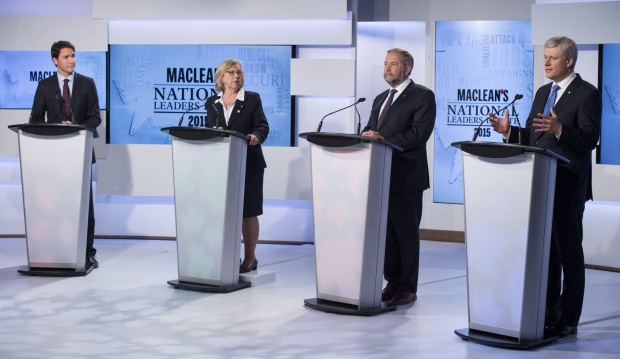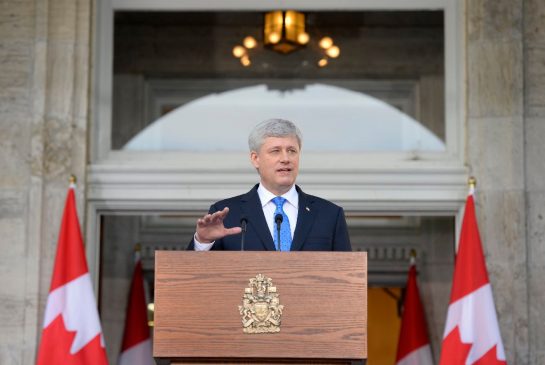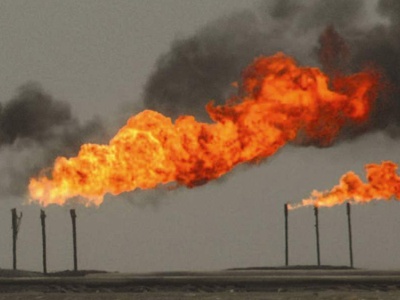
A Gold Mine of Pending Disaster
The exploration drills have already touched the ground but Quebecers are uneasy. The Quebec government aspires for energy independence within the coming years. What is expected to be a large economic boom might very well be an environmental bust.
Marcellus Shale rocks are black rocks that contain a trapped reservoir of natural gas. This new supply would serve to increase independence from foreign oil and gas once it is extracted.
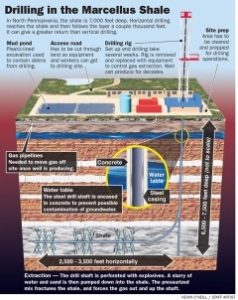
“In 2006 and 2007, oil and gas companies began doing exploratory shale gas work in Quebec in a formation called the Utica shale.”
From this period of time, 28 wells have been dug and hydraulic fracturing has been used in 15 of them. The natural gas industry said that its early results show a large amount of shale gas is available in Quebec. 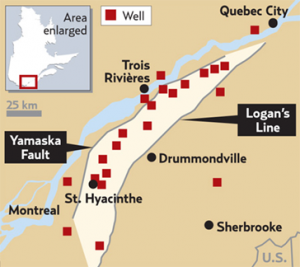
Shale gas can be found in a region that stretches across the eastern St-Lawrence River and south eastern Quebec between the Yamaska Fault and Logan’s line which can be found as an area on the southeastern edge of the St-Laurence River and stretching down into the United States. (See Image Right)
This region is filled with agricultural land that is responsible for food production. If a disaster were to ever occur, the underground water source would be the first part of the area to get contaminated. Animals and plants that rely on it would be contaminated. Since the gas drilling would take place in agricultural areas, the food supply of the effected region would be contaminated as a result.
“The government of Quebec should look to Pennsylvania, and monitor how it is dealing with its problems with shale gas”
Robert Howarth, Professor of Ecology and Environmental Biology at Cornell University.
“A growing chorus of scientists is arguing that not enough is known about the effect widespread gas drilling will have on water supplies, air quality and human health to justify the intensive development of the resource already taking place.”
In More Detail: The Process of Extracting Natural Gas from Shale Rocks
Shale gas will be extracted from shale rocks that are from two to seven kilometers below the ground level using a drill and a high pressure of water.
Once the drill has reached the shale gas, it will start to drill at an angle until reaching the core of the supply where the rock will be drilled horizontally. Once the pathway has been built, water will be pumped into the newly formed tunnel at high pressure and will capture the gas and bring it back to the surface where it will be stored in silos until its purchase or relocation.
Once the drill has been built, the site that the drill takes up is reduced and restored.
Here are some videos that demonstrate the drilling process.
How the Drilling of Shale will Effect Economics and People’s Wallets
“In the last few years, we have discovered the equivalent of two Saudi Arabia’s of oil in the form of natural gas in the United States.”
In Quebec, The Calgary Herald reported in April 2008 that Forest Oil Corp. said shale rocks in the St. Lawrence lowlands alone could contain as much as 4.1 trillion cubic feet of unconventional gas reserves.
Quebec currently consumes about 500 million cubic feet of natural gas per day, almost all of it imported from Alberta.
Forest Oil Corp. told The Calgary Herald, the individual vertical wells could produce about one million cubic feet per day with comparable horizontal wells that are capable of producing four to five times as much daily.
A New Job Sector
According to an article in the Bloomberg BusinessWeek, Ziff Energy’s Director of Gas Consulting Edward Kallio said the ongoing project is expected to create 10,000 new jobs in Quebec over the next few years. He also said that local gas production would increase revenue from royalties and taxes while allowing Quebec’s independence from western Canadian shipments to flourish.
The Quebec Government has been planning this drill for some time.
“We want to create a fiscal and legal framework that can make a company decide to invest in Quebec rather than Pennsylvania.”
Nathalie Normandeau, Quebec’s Minister of Natural Resources and Deputy Premier
Hydro Quebec is currently responsible for 95% of Quebec’s energy needs while gas is used primarily for heating and industrial purposes. Electric heating is always an option. With a new shale gas extraction, it is possible that shale gas will collaborate or even compete with hydroelectricity in an attempt to get more cost-effective energy for businesses and homes.
According to the Quebec government, natural gas already accounts for 13% of Quebec’s energy consumption in comparison to oil that accounts for 38%. According to BusinessWeek, the energy generated from gas is used for heating and by industry.
The government has the intentions of expanding this usage.
“If we are able to start producing gas, I can see a day when it will play a bigger role than oil in meeting our energy needs.”
Nathalie Normandeau, Quebec’s Minister of Natural Resources and Deputy Premier
This would also suggest greater competition between hydro and gas as the main energy sources in Quebec.
However, operating new drills in an expansion process won’t be cheap. According to an article in The Globe and Mail, Michael Binnion, chief executive officer of Questerre, a Calgary-based oil company that plans to drill in Quebec’s shale gas boom said that the cost of building each well would be upwards of $15-million, two to three times the operating cost of wells outside of Quebec. He said the reason for the price difference is the lack of maturity in the gas market in Quebec and the fact that the tools that are required for the drill rigs will have to be imported from elsewhere.
In order for Quebec to be able to bring down gas prices, the Quebec government would have to invest $500-million in 50 wells, Binnion said to The Globe and Mail.
The Personal Financial Aspect of Shale Gas
“It won’t affect our wallets in the short term. Thirty to 40 years ago, oil was the cheapest option for heating houses. Five years ago, it was cheaper for me to heat my house with oil but the price of oil has since went up, so it’s now cheaper to heat the house with electricity.
We don’t need natural gas, but as a customer it is better for us to have choices and if we depend on other countries to have enough oil to answer our needs – we don’t decide the oil price, we only pay it. As a citizen it is better to have choices and beat prices with different energy strategies.
The main benefit for the consumer is more choices. Prices will never go down, but the rate at which they increase will stabilize and become lower in the long term.
We can live a happy life with only oil and electricity, but if we think as a community, the need for natural gas is higher.”
Jacques Des Groseilliers, a Management Consultant who has worked for large companies such as Hydro Quebec, Rio Tinto, Domtar and Radio Canada
Natural Gas Consequences at a Glance
“If you look at the issue with an environmentalist point of view, it is evident that the cleanest way of making energy is to make electricity. We don’t really know if the production of natural gas is clean enough, but we will know that in a few years. Those who produce it say it is safe. Remember that in US, they said that with the oil catastrophe.”
Jacques Des Groseilliers, a Management Consultant who has worked for large companies such as Hydro Quebec, Rio Tinto, Domtar and Radio Canada
It is always a good idea to learn from other people’s mistakes – something that will make or break the shale gas project. Philadelphia has been a very good model to look at considering their experiences with it. Within these observations and events, we learn that shale gas and natural gas in general isn’t the safest energy source.
An Explosive Danger
“The fiery blast was latest natural-gas disaster to raise questions about the safety of the U.S.’s aging, 2.5-million-mile network of gas and liquid pipelines.”
“Everything falling and crashing, glass, just a nightmare. There was no odor, there was no smell. Then it was like all hell broke loose.”
From explosions to flammable water, shale gas is consistently leaving a mark on society. From the enrichment that it brings comes environmental risks that directly affect those around it.
Water Contamination that can be Flammable
“Quebec should go slow and wait until these problems are solved before choosing a messy and dirty process that contaminates the air and water.”
Robert Howarth, Professor of Ecology and Environmental Biology at Cornell University.
In 2008, Andrew Burger from Triple Pundit reported that 4.5 million gallons of water is used in order to pump out the gas in each constructed well. The contaminated water was then trucked to disposal areas where the water would disappear. Documented reports of contaminated well water are growing in the Fort Worth area where this drill was taking place.
Shale gas to blame for flammable water.
The Times Tribune reported in June that groundwater pollution isn’t quick or easy to alleviate.
“Everyone assumed in 1992” that the oil from the spill was “going to disappear. Yet it is still there. That is the problem with groundwater pollution. It doesn’t go away fast.”
Michel Boufadel, an engineering professor at Temple University
The contaminants in the water that is brought to the water treatment facility would sink below a measureable point in the aquifer and not be measured – this is the same phenomena with groundwater monitoring wells. This means that contaminants go unnoticed because they aren’t accessible due to its chemical properties.
The Answer Lies in the Mist
With the American Environmental Protection Agency (EPA) report on shale gas to be released no sooner than 2012, experts advise a slowdown in exploration and exploitation of shale gas.
“A growing chorus of scientists is arguing that not enough is known about the effect widespread gas drilling will have on water supplies, air quality and human health to justify the intensive development of the resource already taking place.”
“Quebec should go slow and wait until these problems are solved before choosing, what is now, a messy and dirty process that contaminates the air and the water.”
Robert Howarth, Professor of Ecology and Environmental Biology at Cornell University.
With the lack of decisiveness and the seriousness of the consequences, a wrong move could lead to disaster. However, if we knew that shale gas would have no effect on the quality of life, then it would serve as a major economic boom.
“We don’t know the consequences because nor does the gas industry or government tell us enough information. Exploiting natural gas is too new for us, there aren’t many reliable studies. We should stop developing the exploitation until we have information. But if we can exploit shale gas safely for the environment and population, we should go in that business because we will diminish the need of foreign oil and if we have surplus, we can sell it to Canada and United States.”
Jacques Des Groseilliers, a Management Consultant who has worked for large companies such as Hydro Quebec, Rio Tinto, Domtar and Radio Canada


